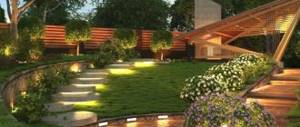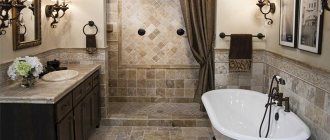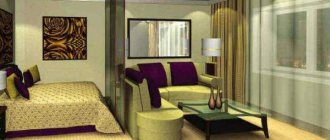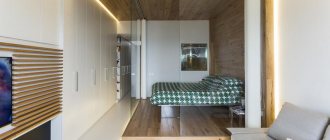Published: January 27, 2016
Thanks to its simplicity and naturalness, the Russian style in the interior of our apartments is finding more and more fans. People often mistakenly believe that decorating an apartment in the Russian style, or as it is also called country style, consists of using folk art items, but this is far from the case. Of course, wooden dishes and furniture, Gzhel, Khokhloma, Dymkovo toys and Palekh miniatures create a certain impetus in the folk direction of country music, but these are not all components of the Russian style.
- Distinctive features of the Russian style
- Accessories in a Russian style setting
The concept of the image of Russian style and its types
Russian style in the interior of a room is a collective image, and has no clear boundaries or recommendations. If you wish, there are three directions that you can follow when decorating your apartment in country style:
- The “A la Russe” style is more of a kitsch style, since it simply collected everything that is known about the decoration for which Rus' was famous. Somewhere he added, somewhere he exaggerated, he mixed both wealth and poverty. A room decorated in this style will more likely resemble a souvenir shop or a folk art museum. Due to its originality, it is more often found in hotels for foreign tourists than in ordinary residential premises.
Photo: style “a la rus”
- “Russian hut” - a room or house decorated in this style will not look rich. The main feature of this folk-style interior is the preservation of traditions created over centuries. It reflects the decoration of the home of a person who lived in Rus' and had average income. All the things that create this interior will carry a semantic load, but there simply won’t be any unnecessary or unnecessary things. This type of Russian style is very much loved by people living in the city; it displays all the pronounced features of a Russian hut. All furnishings of the apartment, decorated in country style, are made from natural materials.
Photo: “Russian hut” style
- “Terem” - the basis for creating an interior in this style is taken from princely houses or palaces, which is why it is most attractive to lovers of colorful decoration. Everything here breathes with bright colors and attributes of Russian antiquity. Of course, the material from which the interior decoration and decorative elements are made is wood. But, unlike the previous country style, the wood is almost always covered with interesting patterns. Very often, such an interior is complemented by a tiled stove. If the size of your home is limited, then you can replace it with a decorative fireplace, the design of which reflects the spirit of antiquity.
Photo: “terem” style
Whatever option the owners of the room choose, it will be original and charming in its own way, and a room decorated in this style is always attractive.
Advice: the main thing is to be careful and not get carried away by the little things. By overloading the overall appearance of the house with an abundance of decorative details, you can simply distort the very idea of creating a Russian style in the interior.
What is the Russian style in the interior?
More famous is the “a la russe” style, the image of a Russian hut. This style is perfect for a country house, cottage or bathhouse, and goes well with the natural landscape. The main material is, of course, wood, such as birch or pine. Sometimes designers give them an aged look. The Russian hut had benches for seating, chests for clothes, a large dining table with an embroidered tablecloth, and a large stove. Of course, it is impossible to install a stove in a modern apartment; at best, it will be a small fireplace.
Distinctive features of the Russian style
Before choosing the Russian style on the Internet for arranging your own home, you must remember that it was based on the influence of a temperate climate and national traditions. Therefore, you need to be guided by the simplest principles when creating a country style in your home, and then it will be comfortable and original. Its main characteristics are the following indicators:
- Naturalness. When choosing materials for finishing, it is necessary to use natural materials. It could be wood, painted or not, or stone.
- Color spectrum. It will depend on which type of Russian interior is closer to you. When decorating a room in the “princely mansion” style, it is imperative to use bright and rich colors. And if you decide to decorate your apartment in the interior of an ordinary “Russian hut”, then white and red colors will be enough here.
- Furniture. To create optimal proximity to the original, it is better to use ordinary wooden furniture. To give it originality, it is possible to resort to carving.
- Doors and windows. It is impossible to imagine a Russian hut or princely lodgings without massive doors and windows with shutters. Of course, if lovers of the Russian style live in an ordinary city apartment, then there can be no question of any shutters. In this case, you can limit yourself to curtains made from natural fabrics.
Tip: to add some variety to the decor, you can complement the wall decor by painting floral patterns with the addition of gold paint.
Photo: decorating the living room with symbolic crafts
Photo: bathroom decorated in Russian style
Main trends in landscape design of Russian gardens
The Russian garden is, first of all, ease and naturalness. Beauty is skillfully combined with practicality: flowering flower beds are adjacent to a small vegetable garden. This is what distinguishes the design of a Russian garden from others. It should be slightly “disheveled”, “unkempt”, not as clearly planned down to the smallest stump, like German or Dutch. This should not be taken as a command: you don’t need to take care of the garden, let it grow on its own. On the contrary, it is much more difficult to create the effect of slight neglect than a “polished” garden with exotic plants at every turn.
So, the Russian garden does not accept any exoticism, complex compositions, multi-level fountains and fancy stones. However, every tree, every flower or decorative element must be carefully thought out and have its place.
The next feature is the abundance of wooden buildings. In addition to the central element of the site - the house, there should be outbuildings, furniture for relaxation, and places for receiving guests. This will be written in detail a little further.
The Russian Garden is a living garden. Therefore, when designing it, it is necessary to immediately allocate space for flower beds and lawns, trees and shrubs.
It is not recommended to use decorative tiles. Paths and paths should wind and not be straight. They are made ground or decorated with bark. Everything is in maximum harmony with nature. Formation of territory. We divide the site into zones
Historically, the formation of the territory of the estate began with the house - the central element. Alleys, paths and paths diverged from it in different directions. A path leading to the front porch was laid across the entire front of the park. Along it there were fountains, sculptures and flower beds.
For those who have decided to create a Russian estate on their site, modern landscape designers offer to divide the site into zones.
Front garden
The front garden is the visiting card of the site. Therefore, its style decision should be related to the general concept of landscape design. For a Russian estate, both a classic closed front garden and an open one are suitable. There is no need to overload it with an abundance of plant varieties; two or three species are enough. They should be bright and bloom all summer.
One of the options for decorating a front garden is planting plants with different flowering periods. Then the picture outside the window will constantly change. For example, crocuses will bloom in early spring, peonies will bloom in early summer, phlox and lilies will bloom in mid-summer, and asters and chrysanthemums will bloom by the end of summer.
Rest zone
For relaxation and receiving guests, it is worth highlighting a separate place where you can place a barbecue, a gazebo, benches for relaxation, a playground, or hang a hammock between the trees.
This area is decorated with small arches with climbing plants. It does not carry any special stylistic load, so it is designed quite modestly.
House
The ideal option for the Russian style is a solid two-story house made of treated logs on a high base.
It is somewhat reminiscent of a boyar's mansion. The indescribable aroma of wood will create a special climate inside it.
Garden
The garden should be small. What to grow on it? It depends on personal skills and preferences. Since ancient times, the garden has always been closed from prying eyes. This trend has carried over into modern design. You can hide your beds in the Russian garden behind a discreet fence.
It is worth experimenting with the theme of an apothecary garden, which was sure to be in every Russian estate. You can plant medicinal plants along with your favorite vegetables, or you can arrange separate beds. You shouldn’t take more than 10-15 species: they don’t last long, so why grow too many? A wonderful and useful ensemble will include: calendula, elecampane, peppermint, oregano, lavender, sage, rosemary, lemon balm, hyssop, comfrey, blue cyanosis and many other herbs.
Economic zone
It contains a well, a cellar, a barn - purely household buildings, and a bathhouse. Considering that a bathhouse, or rather a trip to one, is relaxation for the soul and body, special attention should be paid to the design of the area adjacent to it.
As a rule, there are two small benches and a table near the bathhouse. Plants with a spicy, invigorating aroma are planted. Most often these are dwarf conifers - juniper, balsam fir, yew; or well-known fragrant plants - wormwood, mint, oregano and others. Outbuildings and a bathhouse must be made of the same material as the house.
Garden
The appearance of the Russian garden You can’t tell about it in a few words, so let’s take a detailed look at all aspects of its creation.
Coloristics
The colors used in such a garden are light, calm - sand, a shade of fresh wood, white, blue, the whole spectrum of green, soft apricot. Flowers in flower beds or ornamental shrubs will become bright accents. Garden sculptures in pastel colors will highlight the lush green foliage.
Plants
As mentioned above, a Russian estate has never existed without a garden. It will not be possible to recreate the grandeur and scope of the gardens described in the works of the classics on a small summer cottage. But you can try and make sure that a modest and elegant garden with elements of a manor style pleases the eye and soul.
For a Russian-style garden, there is naturally a reasonable combination of beauty and practicality, so you can safely place a greenhouse next to the rose garden. But it is still more logical to divide the garden area into several parts, the location of which will depend on the taste of the gardener and on the size of the plot. Each part will be populated with certain plants and decorated differently from the others.
Flower beds are made as bright and colorful as possible. You should not decorate them with stones or decorative fences. Simply planting a scattering of flowers is enough. When they bloom, the multi-colored “cap” will hide all design flaws if they were made during the planting process. Therefore, you need to pay attention to the flowering period of plants; it should be approximately the same to create that very “cap”.
Among annual plants, preference is given to aster, calendula, cosmos, petunia, and nasturtium. Perennial plants will also look good in the flowerbed: columbine (aquilegia), bells, carnations, phlox, lupins, garden daisies, aconites. Bulb plant lovers need not worry - their favorites will not be left out. Tulips and daffodils, hyacinths and lilies - there is enough space for everyone.
When decorating flower beds in the style of a Russian estate, do not forget about irises, primroses, marigolds, dahlias, gilly leaves, sweet peas and decorative (winged) tobacco. These plants have long been familiar to almost every gardener and do not require special skills in cultivation and care. Perfect for beginners who have decided to create a Russian garden at their dacha.
It is worth noting that flower beds do not need to select plants based on color and height. Moreover, landscape designers are for mixborders with both hands.
A flower garden of free outlines, in which plants of different heights, flowering periods and types coexist peacefully. A well-groomed and well-planted mixborder will add a fresh note to the appearance of a Russian garden.
It is appropriate to use wildflowers, as well as plants with a strong aroma - these are water mint, thyme (thyme) and fenugreek. It is better to plant them not in flower beds, but along paths, so that when walking along them you can enjoy the spicy aroma.
Red and white creeping clover will perfectly decorate open areas of the garden and at the same time strengthen the soil. It can be combined with other forage plants. The remaining open spaces can be sowed with speedwell, bedstraw or marianberry.
Considering that a Russian garden implies the presence of trees that provide abundant shade, it is worth choosing suitable shade-tolerant plants in advance. Natural views are combined with decorative ones. The following plants will grow well in partial shade: periwinkle, jasmine, fern, lily of the valley, and lungwort.
You can’t do without primroses so that the garden is beautiful not only in summer and autumn, but also in early spring. Crocuses, iridodictiums: purple, yellow, white, blue and, of course, snowdrops.
In well-lit and most visible places you can build a small rose garden. Tall, bright sunflowers planted in peculiar islands will also look organic.
The highlight of such a garden will be some kind of apothecary garden with mint, oregano and hyssop.
Shrubs
A typical Russian flavor is conveyed by fragrant shrubs: jasmine, lilac.
The raspberry, gooseberry and currant bushes will not only please the eye, but also produce a harvest. Every gardener already has them, so if you decide to remodel your existing garden, there will be no problems purchasing them.
You can supplement existing shrubs with viburnum and barberry.
An original shrub, the European euonymus, will help add a drop of brightness. It has a dense and spreading crown with a height of 1.5 to 3 m. A very interesting plant that blooms profusely in May and June. The flowers are small, yellowish-green, unfortunately, almost invisible. But with the onset of autumn, the euonymus will decorate the garden with fancy pink-red fruit boxes.
If there are children in the family, you should not plant euonymus, since its bright fruits are poisonous (they have a strong laxative and emetic effect).
Safe and unpretentious, but no less lush and bright, viburnum leaf. The color of its foliage depends on the variety and can be yellow, dark green, purple or dark red. The use of bladderwort in a Russian garden can be varied: planted singly on the lawn, placed under a tree canopy or even in a flower garden, or added to large coniferous plants: thuja or juniper. An interesting experiment would be to plant it next to smaller deciduous shrubs and herbaceous perennials. Choosing a place and neighbors for a bladderwrack gives scope to the gardener’s imagination and personal preferences.
Trees
A Russian garden cannot get by with flowers and shrubs alone; it also needs to be landscaped with trees. Deciduous, coniferous, but most often fruit, since they are both beautiful and useful, and do not take up very much space (considering the area of the plot).
Apple trees (including wild ones), pears, cherries - something that has long been familiar and loved by everyone.
You can diversify fruit trees with apricots and cherries, provided the climate is favorable for them. Sea buckthorn and rowan are worthy touches to the overall picture of the Russian garden. They will both perform a decorative function and bring a harvest.
If the owner of the dacha is lucky and has a large plot of land available, the queens of Russian noble estates - linden trees - are suitable for planting.
As an option, it is recommended to plant or not cut down if they are already growing: spruce, pine, birch, oak, maple.
Tips for arranging a Russian garden
- You cannot purchase mature imported trees. No matter how strong the desire to quickly see your territory completed. If trees have been growing for several years in a different climate and on different soil, they find it difficult to take root, require more care, and are more often damaged by pests.
- In order for domestic seedlings to take root better, they should be planted in late autumn.
- To design paths, you can use cut logs. This is one of the latest fashion trends, but, unfortunately, this option is short-lived and requires constant updating.
- The use of sandstone is relevant. In the cracks between the stones you can fill the soil with the seeds of shade-loving grass.
- If the plot has just been purchased and there is a forest on it, there is no need to rush to cut down all the trees. They can be used to form a beautiful landscape part of the garden.
- If the size of the garden is larger than the standard six acres, you should alternate the type of space - open meadows with closed parts of coniferous or deciduous trees.
- When choosing a Russian estate style for a garden, it is better to choose a classic style for a home.
- The vegetable garden is located behind the house or on the sides of it. The important thing is that it should not interfere with the perception of the garden itself.
- The basis of garden color is the play of light and shadow. For example, light garden elements against a background of dark greenery.
Thus, it is very clear that landscape design in the style of a Russian estate and its main element, the garden, combine practicality and simple beauty. And although creating this style requires a considerable investment of effort and money, the result is worth it!
Source











